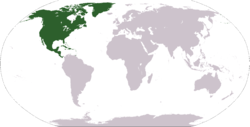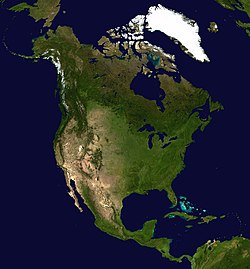North America
From Wikipedia, the free encyclopedia.
North America is a continent in the northern hemisphere, bordered on the north by the Arctic Ocean, on the east by the North Atlantic Ocean, on the south by the Caribbean Sea, and on the west by the North Pacific Ocean. It covers an area of 9,355,255 mi² (24,230,000 km²). In 2001 its population was estimated at 454,225,000. It is the third largest continent in area, after Asia and Africa, and is fourth in population after Asia, Africa, and Europe.
Both North and South America are named after Amerigo Vespucci, who was the first European to suggest that the Americas were not the East Indies, but a previously undiscovered (by Europeans) New World.
North America occupies the northern portion of the landmass generally referred to as the New World, the Western Hemisphere, the Americas, or simply America. North America's only land connection is to South America at the narrow Isthmus of Panama. (For geopolitical reasons, all of Panama – including the segment east of the Panama Canal in the isthmus – is often considered a part of North America alone.) According to some authorities, North America begins not at the Isthmus of Panama but at the Isthmus of Tehuantepec, with the intervening region called Central America and resting on the Caribbean Plate. Most, however, tend to see Central America as a region of North America, considering it too small to be a continent on its own. Greenland, although a part of North America geographically, is not considered to be part of the continent politically.
Contents |
Physical features
Plate tectonics recognizes the vast majority of North America as being the surface of the North American Plate. Part of California is known for being the edge of the Pacific Plate, with the two plates meeting along the San Andreas fault.
The continent can be divided into four great regions (each of which contains many sub-regions): the Great Plains stretching from the Gulf of Mexico to the Canadian Arctic; the geologically young, mountainous west, including the Rocky Mountains, the Great Basin, California and Alaska; the raised but relatively flat plateau of the Canadian Shield in the northeast; and the varied eastern region, which includes the Appalachian Mountains, the coastal plain along the Atlantic seaboard, and the Florida peninsula. Mexico, with its long plateaus and cordilleras, falls largely in the western region, although the eastern coastal plain does extend south along the Gulf.
The western mountains are split in the middle, into the main range of the Rockies and the coast ranges in California, Oregon and Washington, with the Great Basin – a lower area containing smaller ranges and low-lying deserts – in between. The highest peak is Denali in Alaska.
Since 1931, Rugby, North Dakota, has officially been recognized as being at the geographic center of North America. The location is marked by a 4.5 metre (15 foot) field stone obelisk.
|
North American cratons and basement rocks. |
North American craton. |
Regional and political divisions
On the main continent landmass, there are three large and relatively populous countries:
- Canada - many large islands off the shore of North America belong to Canada, including Vancouver Island and the Queen Charlotte Islands on the west, Prince Edward Island, Newfoundland and Cape Breton Island on the east, and Ellesmere Island, Baffin Island, and Victoria Island to the north)
- Mexico - the Revillagigedo archipelago and numerous smaller islands off its coast belong to Mexico
- The United States - the 48 contiguous states and Alaska are part of North America, while the state of Hawaii in the Pacific Ocean is not; the Aleutian Islands south of Alaska also belong to the U.S.
At the southern end of the continent, in a relatively small area known as Central America, are the countries of:
At the southeastern end of the continent lies a chain of islands territories called the Antilles, the Caribbean or the West Indies, which include the countries:
- Antigua and Barbuda
- Bahamas
- Barbados
- Cuba
- Dominica
- Dominican Republic
- Grenada
- Haiti
- Jamaica
- Saint Kitts and Nevis
- Saint Lucia
- Saint Vincent and the Grenadines
- Trinidad and Tobago 1
And the dependencies:
- Anguilla (British dependency)
- Aruba 2 (part of the Kingdom of the Netherlands)
- Cayman Islands (British dependency)
- Guadeloupe (overseas department of France)
- Martinique (overseas department of France)
- Montserrat (British dependency)
- Navassa Island (U.S. territory)
- Netherlands Antilles 1 (part of the Kingdom of the Netherlands)
- Puerto Rico (U.S. commonwealth)
- Turks and Caicos Islands (British dependency)
- British Virgin Islands (British dependency)
- U.S. Virgin Islands (territory of the USA)
Lying in the Atlantic Ocean but considered part of the continent are the dependencies:
- Bermuda, a British dependency found about 1,072 km (670 mi.) southeast of New York City
- Greenland, the largest island in the world and a self-governing dependency of Denmark, which is located in the far north of the continent to the east of Nunavut.
- Saint Pierre and Miquelon, off the south coast of Newfoundland, is the last of France's once vast possessions in America north of the Caribbean.
1 These states and dependencies have territory both in North and South America.
2 These dependencies lie in South America, but are considered North American because of cultural and historical reasons.
See here for details.
The United States, Canada, and the other English-speaking nations of the Americas (Belize, Guyana, and the Anglophone Caribbean) are sometimes grouped under the term Anglo-America, while the remaining nations of North and South America are grouped under the term Latin America.
Alternatively, Northern America is used to refer to Canada and the U.S. together, while Central America is mainland North America less Northern America. The West Indies generally include all islands in the Caribbean Sea. In this respect, Latin America generally includes Central America and South America and, sometimes, the West Indies.
The term "North America" may mean different things to different people. The term in common usage is often taken to mean "The United States and Canada, only" by some people of the United States and Canada, excluding Mexico and the countries of Central America, unless the context makes it clear that they are to be included (such as with specific reference to Mexico, when talking about NAFTA). For example, guides to wild flora and fauna published by the National Audubon Society for "North America" frequently include only species found in Canada and the U.S.
This may be attributed to the fact that culturally and economically, the U.S. and Canada are more alike to each other than they are to the rest of North America. Mexicans, however, are acutely aware that Mexico is a part of North America and object to this usage. Central Americans, however, are generally content to be called Central Americans – largely because of their shared history, which includes several attempts at supranational integration in the region and in which their much larger northern neighbor was never involved.
Political divisions – area and population data
| Name | Area (km²) | Population (2002-07-01 est.) | Population density (per km²) |
|---|---|---|---|
| Anguilla (UK) | 102 | 12,446 | 122 |
| Antigua and Barbuda | 443 | 67,448 | 152 |
| Aruba (Neth.) | 193 | 70,441 | 365 |
| Bahamas | 13,940 | 300,529 | 22 |
| Barbados | 431 | 276,607 | 642 |
| Belize | 22,966 | 262,999 | 11 |
| Bermuda (UK) | 53 | 63,960 | 1,200 |
| British Virgin Islands (UK) | 153 | 21,272 | 139 |
| Canada | 9,976,140 | 32,078,819 | 3.2 |
| Cayman Islands (UK) | 262 | 36,273 | 138 |
| Costa Rica | 51,100 | 3,834,934 | 75 |
| Cuba | 110,860 | 11,224,321 | 101 |
| Dominica | 754 | 70,158 | 93 |
| Dominican Republic | 48,730 | 8,721,594 | 179 |
| El Salvador | 21,040 | 6,353,681 | 302 |
| Greenland (Denm.) | 2,166,086 | 56,376 | 0.03 |
| Grenada | 344 | 89,211 | 259 |
| Guadeloupe (Fr.) | 1,780 | 435,739 | 245 |
| Guatemala | 108,890 | 13,314,079 | 122 |
| Haiti | 27,750 | 7,063,722 | 255 |
| Honduras | 112,090 | 6,560,608 | 59 |
| Jamaica | 10,991 | 2,680,029 | 244 |
| Martinique (Fr.) | 1,100 | 422,277 | 384 |
| Mexico | 1,972,550 | 103,400,165 | 52 |
| Montserrat (UK) | 102 | 8,437 | 83 |
| Navassa Island (U.S.) | 5 | 0 | n/a |
| Netherlands Antilles (Neth.) | 960 | 214,258 | 223 |
| Nicaragua | 129,494 | 5,023,818 | 39 |
| Panama | 78,200 | 2,882,329 | 37 |
| Puerto Rico (U.S.) | 9,104 | 3,957,988 | 435 |
| Saint Kitts and Nevis | 261 | 38,736 | 148 |
| Saint Lucia | 616 | 160,145 | 260 |
| Saint Pierre and Miquelon (Fr.) | 242 | 6,954 | 29 |
| Saint Vincent and the Grenadines | 389 | 116,394 | 299 |
| Trinidad and Tobago | 5,128 | 1,104,209 | 215 |
| Turks and Caicos Islands (UK) | 430 | 18,738 | 44 |
| United States | 9,629,091 | 280,562,489 | 29 |
| U.S. Virgin Islands (U.S.) | 352 | 123,498 | 351 |
| Total | 24,497,994 | 490,354,921 | 20.0 |
See also
- Discoverer of the Americas
- Economy of North America
- European colonization of the Americas
- History of North America
- Birds of North America
External links
| Continents and regions of the World | |||
Antarctica |
Africa-Eurasia |
Americas |
Australia |
Africa |
Eurasia |
North America |
Oceania |
Europe |
Asia |
South America |
Geological supercontinents : Gondwana • Laurasia • Pangea • Rodinia |
| Regions of the World | |
| Africa: | Central Africa | East Africa | Great Lakes | Guinea | Horn of Africa | North Africa | Maghreb / Northwest Africa | Sahel | Southern Africa | Sub-Saharan Africa | Sudan | West Africa |
| Americas: | Andean states | Caribbean | Central America | Great Lakes | Great Plains | Guianas | Latin America | North America | Patagonia | South America | Southern Cone |
| Asia: | Central Asia | East Asia | East Indies | Far East | Indian subcontinent | North Asia | Southeast Asia | Southwest Asia (Middle East / Near East, Levant, Anatolia, Arabia) |
| Europe: | Balkans | Baltic region | Benelux | British Isles | Central Europe | Eastern Europe | Northern Europe | Scandinavia | Southern Europe | Western Europe |
| Eurasia: | Caucasus | Mediterranean | Post-Soviet states |
| Oceania: | Australasia | Melanesia | Micronesia | Polynesia | Aleutian Islands | Pacific Rim |
| Polar: | Arctic | Antarctic |










